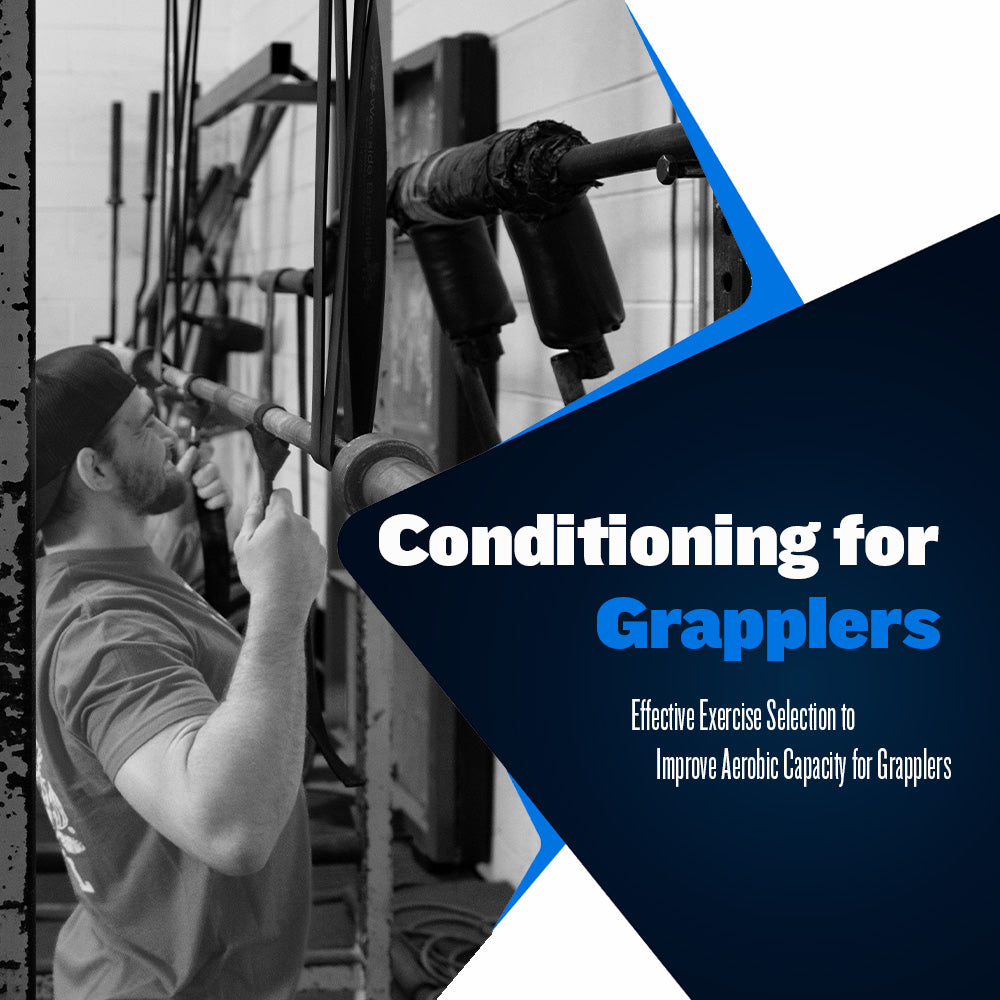Conditioning for Grapplers

No matter the sport, any athlete will benefit from increased aerobic capacity. In sports like Brazilian Jiu-Jitsu and Wrestling, athletes must focus on developing and maintaining a high level of physical conditioning. It doesn’t matter how strong or skilled you are; once your gas tank is empty, all you can do is hope to survive.
When most think of conditioning work, their mind goes to exercises like long-distance jogging or hill sprints. While these exercises are excellent options to choose when building aerobic capacity, they aren’t exactly relative to the sport. If you want to maximize the conditioning for a specific sport, you must find ways to tax and fatigue the athlete relative to their sport.
Think of ways the sport targets different muscle groups, create GPP exercises that will target those groups, and perform these exercises at low to moderate intensities for high to ultra-high volume. It’s not rocket science; for instance, a football player would benefit from low sled pushes, while a hockey player would benefit from lateral step sled pulls.
Here are a few conditioning exercises we program for grapplers at Westside Barbell:
ATP Grappling
One of the most effective exercises we use to improve the conditioning of grapplers is ATP grappling. The ATP is the Westside Barbell Athletic Training Platform, also called a belt squat. This exercise is performed with one athlete using the ATP while another athlete stands outside the machine to act as the opponent.
The athlete standing in the ATP will have the hips loaded with weight via plate weight, band weight, or a combination of both. The idea is to create enough tension for the athlete to maintain constant resistance using the legs and trunk to maintain stability. Then, the athlete standing outside the machine will begin clinching, hand fighting or performing pummel drills with the athlete using the ATP.
This exercise is typically programmed for time. We will generally start an athlete at three to five 1-minute sets and build from there, adding 15-30 seconds to each set as endurance improves.
The idea is simple, simulate sports movements and conditions while amplifying the intensity of the task. In this case, we use the belt squat to cause the legs and trunk to perform more work to create the stability required to negotiate the grappling exchange going on with the upper body. After a few weeks of ATP grappling, you’ll bully opponents in the clinch.
Wheelbarrow Walks
As a grappler, it is important to have a strong grip and grip endurance. Whether you’re trying to gain wrist control, finish a collar choke, or secure a takedown, having a strong grip can make a difference. At Westside, one way we focus on developing grip strength while also developing aerobic capacity is loaded wheelbarrow walks.
We use a wheelbarrow that is specifically made to allow for plates to be loaded. However, you can use a regular wheelbarrow, provided it has the build quality to handle the weights you intend to use. Typically, we will use the heaviest weight we can manage for 25-40 yard trips, 10-12 trips per workout.
Athletes will also perform longer distances for fewer trips. For instance, our athletes will walk a moderately loaded wheelbarrow around the compound, around 200-220 yards per trip. Depending on the athlete, this will be done for as few as one trip or as many as five or six trips.
SSB Sled Pulls
Grappling is a grueling sport that requires an athlete to endure pain and discomfort while having the willpower and gas tank to stay competitive in the most challenging matches or tournaments. One way to make sled drags uncomfortable while building a strong will and improving conditioning levels is by adding in the safety squat bar.
With standard sled pulls, an athlete can allow the upper body to get a bit lazy and pull the sled with a “go through the motions” type of effort. When the SSB is added, the upper body must remain fully engaged with consistent trunk engagement while pulling the sled with an upright torso. Not only will this help your cardiovascular endurance, but also your trunk and torso stability.
We load the SSB and sled similarly to the protocol for loading the wheelbarrow. We will use the heaviest sled and SSB weight while safely completing all prescribed trips at full distance. Athletes should perform this exercise for 10-12 trips for 25-40 yards or 1-6 long-distance trips.
Difficult Training, Easy Competition
As we mentioned above, exercises such as long-distance running and sprints, or other similar exercises, are great ways to improve your aerobic capacity. However, when you compete in sports that require athletes to exert physical force both in short bursts and for long periods, you must find ways to condition athletes that mimic the work performed in the competition.
Can grapplers benefit from road work and sprints? Yes. However, given the challenging nature of the sport and the demand placed on an athlete in competition, more intense approaches are necessary if an athlete wants to reach the next level. A couple-mile jog does not mimic the demand or intensity placed upon an athlete during a 3-minute period of grappling.
When it comes to conditioning work, make it taxing and challenging, but make sure it serves the proper purpose. The idea is to improve aerobic capacity, obtain strength endurance benefits, and make an athlete tougher. Strength can break an opponent physically. However, having the endurance to push the pace an entire match will break an opponent mentally. Do not neglect this critical aspect of training.
Sources:
Simmons, L (2015). Special Strength Development for All Sports. Westside Barbell
Simmons, L. (2007). Westside Barbell Book of Methods. Westside Barbell.
Verkhoshansky, Y., & Siff, M. C. (2009). Supertraining. Verkhoshansky.





